You are here
Saiga tatarica in Kazakhstan.
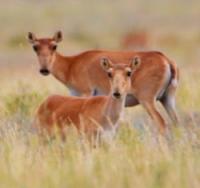
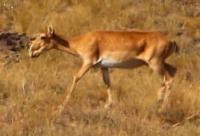
Photo tours for Saiga tatarica in Kazakhstan.
“On the steppe plains near Borysthenes, Tanais and Ra there is a forest sheep, called by the Poles Solhac, and by the Muscovites - saiga (Seigack), the size of a roe deer, but with shorter legs; her horns are stretched upward and seem to be marked with rings; Muscovites make transparent knife handles from them. They are very fast and jump very high."
“Notes on Muscovy” (Rerum Moscoviticarum Commentarii - “Notes on Muscovite affairs”). 1549. Baron Sigismund von Herberstein.
“Saiga, or wild goat (Pallas calls it cervus pygargus, and Mr. Eversman Anttlopa saiga). Herds of these animals are very numerous in the Kirghiz-Cossack steppes; and sometimes extend, as they say, to ten thousand heads. In the article about hunting we will tell you how to catch them and shoot them.
The saiga's snout is bulbous, its nostrils are wide, its vision is not always clear, because growths sometimes form on its eyes; but the sense of smell, or sense of smell, is very subtle, and therefore she senses the approach of a predatory animal or person in the wind.
It is no larger in size than a domestic goat, but its fur is smooth, short and usually dark yellowish in color; The horns are not large and steep, the legs are thin and dry, and the speed of her running is amazing. With this ability and high jumps, very often repeated, she escapes from her enemies.
However, it can easily be accustomed to people and made tame in its youth. Of the many steppe herbs she uses, she especially loves white wormwood and brown sea wormwood. Its meat is very tasty, but sometimes worms are found in it, on the back.
From this reason, as well as from the heat and insects that fill her nostrils, she apparently suffers and is restless in the summer heat. Baron Meyendorff writes that saigas escape from intense heat in the summer in the following way: one of them hides its head in some hole or place protected from the sun; in the shadows behind it the second hides its head: behind the second the third, etc.
If at this time the first is killed, then the second takes its place; the second is replaced by the third. In this way they kill quite a lot of them.”
Levshin A.I. “Description of the Kyrgyz-Cossack or Kyrgyz-Kaisak mountains and steppes.” 1833.
Photos of Saiga tatarica in Kazakhstan.
Saiga (female), margach or saiga (male; Saiga tatarica) is an artiodactyl mammal from the subfamily of true antelopes (although due to its peculiar anatomy, it is sometimes classified together with the Tibetan antelope in a special subfamily Saiginae).
The Saiga tatarica has long been an emblem of the nature of Kazakhstan, a representative of the bovid family from the order of artiodactyl mammals - a typical inhabitant of desert and semi-desert landscapes.
Initially, saiga tatarica inhabited a large area in the steppes and semi-deserts of Eurasia from the foot of the Carpathian Mountains and the Caucasus to Dzungaria and Mongolia. Now saigas live only in Kazakhstan, Uzbekistan, Kyrgyzstan, with migratory transitions to Turkmenistan, Russia (in Kalmykia, Astrakhan region, Altai Republic, Volgograd region) and western Mongolia. The animal was reintroduced in Ukraine in the Askania-Nova Nature Reserve.
Centuries ago, it also inhabited the arid steppes - from the territory of Kazakhstan to the Black Sea region. However, at the beginning of the XXth century, its habitat area and numbers sharply decreased, and now, after a sharp increase in numbers in the 60s and 70s, when it reached more than 1,000,000 heads, the saiga tatarica has survived only in the arid zone of the Caspian region and Kazakhstan (less than 100,000).
The lambing areas are located in Central Kazakhstan, and for the winter the saiga tatarica migrates to the Betpak-Dala desert, the Aryskum sands, the Aral Karakum desert, the Ustyurt and the southern regions of the Volga-Ural interfluve.
A relatively small artiodactyl animal, body length 110 - 146 cm, tail 8 - 12 cm, height at the withers 60 - 79 cm. Weight from 23 to 40 kilograms. An elongated body on thin, relatively short legs. The nose is in the form of a soft, swollen, mobile proboscis with rounded close nostrils creating the effect of a “humpbacked muzzle”.
Ears with a rounded top. The middle hooves are larger than the side hooves. Only males have horns. They are approximately equal in length to the length of the head and on average reach 30 cm, translucent, yellowish-white, irregularly lyre-shaped, two thirds from the bottom have transverse ring ridges, located almost vertically on the head.
Summer fur is yellowish-red, darker along the midline of the back and gradually lighter towards the belly, without a tail “mirror”, low and relatively sparse. Winter fur is much taller and thicker, very light, clay-gray. They molt twice a year: in spring and autumn.
There are small infraorbital, inguinal, carpal and interdigital specific skin glands. Nipples - 2 pairs. Saigas tatarica are characterized by seasonal concentration - in different seasons of the year they gather in large herds of thousands in certain areas of steppes and semi-deserts and feed on a wide variety of plant species (quinoa, wormwood, wheatgrass, saltwort, etc.), including those that are poisonous to other animal species.
Saigas tatarica migrate long distances and can swim across rivers, but try to avoid steep and rocky slopes. Saigas tatarica amble, reaching speeds of up to 80 km per hour. The mating season begins in November, when males compete for possession of the female.
The male who wins the fight becomes the owner of a “harem” consisting of 5 to 50 females. At the end of spring - beginning of summer, cubs appear - young females often bring one at a time, and adults (in two cases out of three) - two.
The natural enemies of saigas tatarica are steppe wolves. There are five main populations of the species, three of which are in Kazakhstan, one in Russia (Kalmykia) and one in Mongolia. Some saigas tatarica winter in Uzbekistan.
Saiga tatarica is the oldest representative of the so-called mammoth fauna (together with the woolly rhinoceros and the saber-toothed cat). It is assumed that in the Pleistocene they were even more numerous and lived in the cold steppes along with other representatives of the mammoth fauna.
After the Late Valdai glaciation, saigas tatarica ranged from the far west of Europe, including the British Isles, to central Alaska and northwestern Canada. In the XVIIth - XVIIIth centuries, the saiga tatarica inhabited all steppes and semi-deserts from the foothills of the Carpathians in the west to Mongolia and Western China in the east.
At that time, it reached the north to Kyiv and the Barabinsk steppe of Siberia. However, in the second half of the XIXth century, people quickly populated the steppe spaces, and the saiga tatarica almost disappeared from Europe.
The range and number of saiga tatarica antelopes have also sharply decreased in Asia. As a result, by the beginning of the XXth century, it was preserved in Europe only in the most remote areas of the lower reaches of the Volga River, and in Asia - along the Ustyurt, in Betpak-Dale, in the Ili-Karatal interfluve (sands of Saryesik-Atyrau), in the basins of the western lakes of Mongolia and some other places.
In addition to wolves, natural threats to the existence of the species are infectious diseases and icing of the steppes, which prevents food production. In Soviet times, during cold winters, saigas tatarica were saved using specially equipped feeders. In 2012 - 2014, the Ministry of Education and Science of Kazakhstan allocated 332 million tenge for the study of infectious diseases among saigas tatarica.
Saiga tatarica mongolica. The population living in western Mongolia is divided into a separate subspecies - the Mongolian saiga (Saiga tatarica mongolica), the number of which is 750 individuals. All other populations are classified as the nominative subspecies Saiga tatarica.
Some researchers consider the Mongolian saiga to be a subspecies of the Pleistocene and call it Saiga tatarica borealis mongolica. By the 1920s, there was a strong decrease in the number of saiga tatarica and it was almost completely exterminated.
However, thanks to the conservation measures taken and the high fertility of the species, the populations recovered; in the 1950s, their total number in the steppes and semi-deserts of the USSR was more than 2,000,000 individuals.
After the collapse of the Soviet Union, by 2008, approximately 50,000 individuals of the saiga tatarica subspecies Saiga tatarica tatarica remained, which lived in three regions of Kazakhstan (Volga-Ural Sands, Ustyurt and Betpak-Dala) and Russia (Northwestern Caspian Sea).
At one point, animal welfare groups such as the World Wildlife Fund encouraged the hunting of saigas tatarica, calling their horns an alternative to rhino horns. Global saiga tatarica numbers have declined again. In 1996, saiga tatarica was listed as Vulnerable on the IUCN Red List, and in 2002 it was classified as highly threatened.
More than 95% of the world's saiga tatarica population lives in Kazakhstan. According to research by WWF Russia, in 2020, about 6,350 saigas tatarica lived in the steppes of the northwestern Caspian Sea.
To preserve the saiga tatarica population living in the northwestern Caspian region, the Black Earth Nature Reserve was created in 1990 in the Republic of Kalmykia (Russia), which in 2012 acquired a full-fledged electric fence.
There are plans to reintroduce the saiga tatarica in northeastern Siberia, as part of the Pleistocene Park project. 2010 has been declared the Year of the Saiga in the Republic of Kalmykia. On the territory of Ukraine, a small herd of saigas tatarica (about 600 animals) lives in the Askania-Nova Nature Reserve.
The Moscow Zoo and zoos in San Diego and Cologne have had saigas tatarica in their collections in the past.
In Kazakhstan, saiga tatarica population is divided:
- Ural,
- Betpakdala,
- Ustyurt.
In 2023, a census of saiga tatarica population was carried out in Kazakhstan:
- Ural - 1 130 000,
- Betpakdala - 745 300,
- Ustyurt - 39 700.
Total: 1,915,000.
Since 2014, the registration of saigas tatarica in Kazakhstan has been carried out by the Kazakhstan Association for Biodiversity Conservation (ASBC) together with the Committee of Forestry and Wildlife.
In Soviet times, the structure of saiga tatarica protection in Kazakhstan was entrusted to hunting industry enterprises, which were under the jurisdiction of the State Committee of the Kazakh SSR for Ecology and Nature Management.
Their powers included control of industrial shooting and protection of wildlife from poachers. The control and security system was initially built incorrectly. The state instructed hunting industry enterprises to keep records of livestock themselves, and based the shooting plan on numbers.
Usually it did not exceed 20%. In order to obtain higher figures for planned harvests, hunting industry enterprises doubled the number of animals. According to the papers, it turned out that 20% of the herd was shot, but of the real livestock it was 40% or more.
In 1985, due to the high number of saiga tatarica, the Kazakh Zoological Combine was transferred to the responsibilities of commercial harvesting of saigas tatarica and selling their horns on the foreign market.
The enterprise was under the jurisdiction of the Kazakh Main Directorate for the Protection of Wildlife under the Cabinet of Ministers of the Kazakh SSR. From the beginning of perestroika (1985) to 1998, 131 tons of horns were exported. In 1993, legal exports of horns reached the maximum limit of 60 tons.
This had a negative impact on their numbers: if in the early 1990s the total number of saiga tatarica in Kazakhstan was about 1,000,000 animals, then 10 years later the number of animals decreased to almost 20,000.
In 1999, a moratorium on saigas tatarica hunting was introduced, which was extended six times: in 2001, 2005, 2011, 2020, 2022 and 2023. In September 2023, Deputy Chairman of the Forestry and Wildlife Committee Andrei Kim said that next year the ban on shooting saigas tatarica would not be extended:
On September 19, 2023, the saiga tatarica was included in the list of animal species whose numbers are subject to regulation in order to prevent damage to the environment and prevent the risk of causing significant damage to agricultural activities.
In Semirechye, saiga tatarica is found in the northern forest-steppe zone, from where it migrates for the winter to the less snow-covered deserts and semi-deserts bordering the Tien-Shan. Sometimes herds of animals invade the Chui Valley, where they die not so much from wolves, but because of hunting.
Saigas tatarica are very cute and at the same time incredibly shy animals. With their soft, mobile proboscis nose, saiga filter steppe dust and warm their breath in frosty weather. Saigas tatarica are the same age as mammoths; 90% of this rare animal species is actually found only on the territory of Kazakhstan.
Saigas tatarica are an animal susceptible to stress. It responds to the slightest sounds and minimal movements. In March 1990, the public committee decided to form a commission under the leadership of the member of the committee’s presidium, corresponding member of the Academy of Sciences of the Kazakh SSR I.Ya. Chasnikov to determine the causes of the mass death of saigas tatarica that took place in May 1988 in the Turgai region.
In one day, about 255,000 animals died here, and over the entire spring period - about 434,000. Experts who studied for two years did not come to a consensus, and the results of the research were not made public.
The Committee informed that similar phenomena had occurred previously, in particular, at the end of the 70s in the Dzhangeldinsky district of the Turgai region, when local residents witnessed a mass death of saigas tatarica.
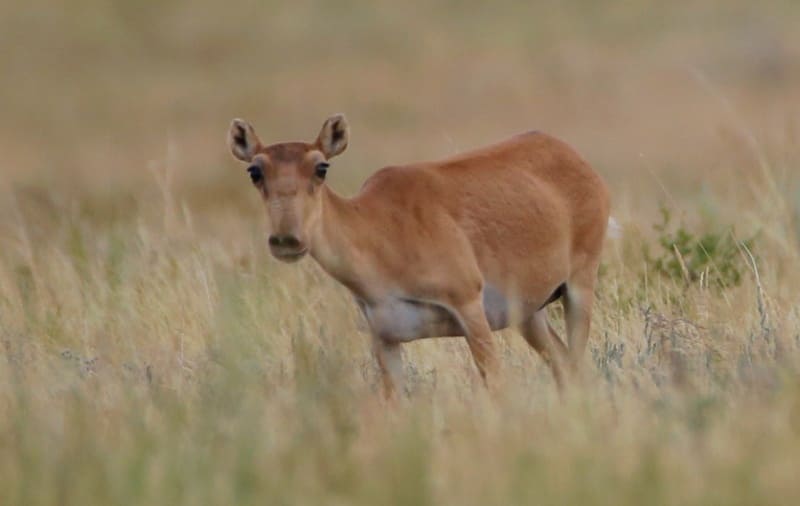
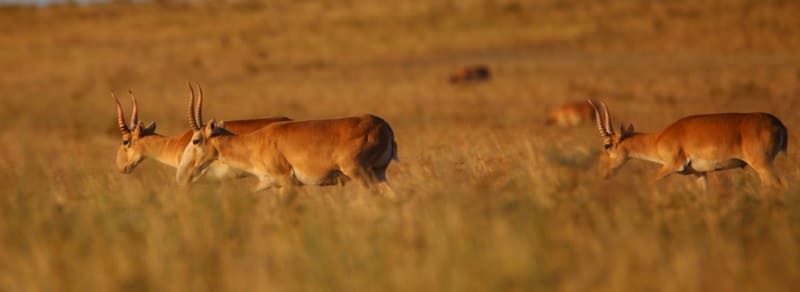
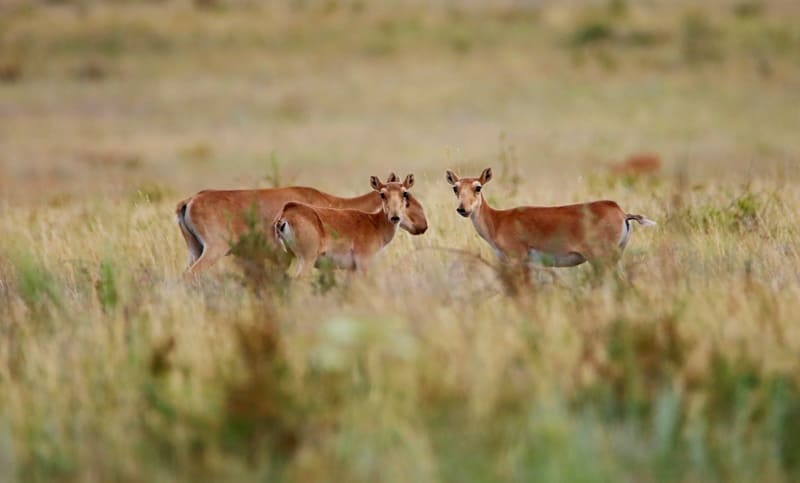
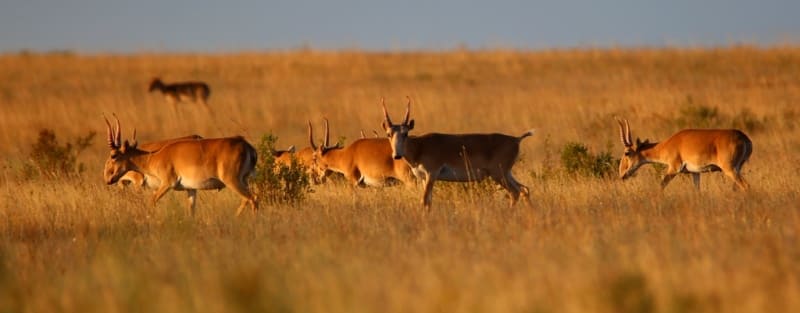
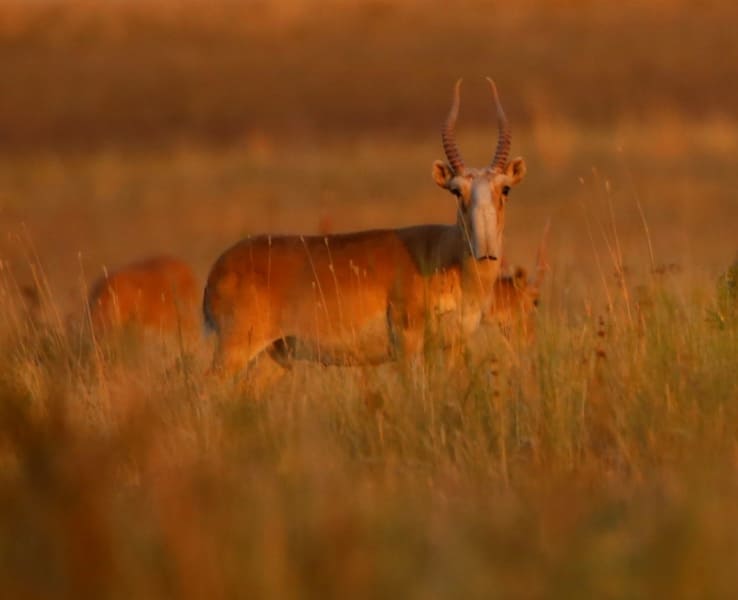
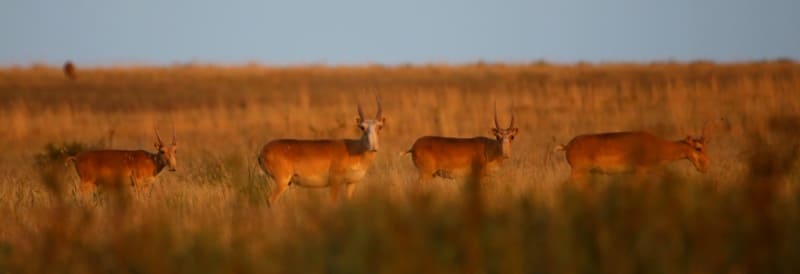

Authority:
https://ru.wikipedia.org/wiki/%D0%A1%D0%B0%D0%B9%D0%B3%D0%B0
Photos by:
Alexander Petrov.







